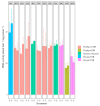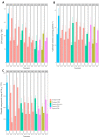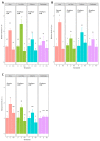Desiccation Stress Tolerance in Porphyra and Pyropia Species: A Latitudinal Analysis along the Chilean Coast
- PMID: 36616141
- PMCID: PMC9824847
- DOI: 10.3390/plants12010012
Desiccation Stress Tolerance in Porphyra and Pyropia Species: A Latitudinal Analysis along the Chilean Coast
Abstract
One of the most important factors regulating the distribution and abundance of seaweeds is desiccation, triggered mainly by tidal changes and climatic variation. Porphyra and Pyropia species have evolved multiple strategies to tolerate desiccation stress; however, how these tolerance strategies differ in these species inhabiting different latitudes is still unknown. In this context, we analyzed, in situ, the physiological responses of these species (collected from 18° S to 41° S along the Chilean coast) to desiccation stress using biochemical and molecular analyses. The hyper-arid terrestrial climate of northern Chile, with high evaporation and lack of constant rain determines a very steep increase in desiccation stress in the upper intertidal during low tide for these species. Accordingly, the results showed that, in comparison with the southernmost populations, the Porphyra/Pyropia species from the north zone of Chile (18°-30° S) exhibited higher contents of lipoperoxide and carbonyls (1.6-1.9 fold) together with higher enzymatic activities, including ascorbate peroxidase, catalase, peroxiredoxin, and thioredoxin (2-3-fold). In addition, a substantial expression of cat, prx, and trx transcripts during desiccation was demonstrated, mainly in the northernmost populations. These results provide evidence of (i) significant activation of antioxidant enzymes and transcripts (principally cat and prx); (ii) participation of phenolic antioxidant compounds as a highly plastic physiological strategy to cope with desiccation; and (iii) the activation of the tolerance responses was affected by species latitudinal distribution. Thus, for the first time, this study integrated the biochemical and genetic responses of diverse Porphyra/Pyropia species to better understand their physiological dynamics of tolerance over a wide latitudinal range.
Keywords: Laver; Luche; Nori; antioxidants; desiccation stress; latitudinal distribution; ocean warming; oxidative stress; reactive oxygen species; red seaweeds.
Conflict of interest statement
All authors certify that they have no affiliations with or involvement in any organization or entity with any financial interest. The authors declare no conflict of interest.
Figures






References
-
- Contreras-Porcia L., López-Cristoffanini C., Meynard A., Kumar M. Tolerance Pathways to Desiccation Stress in Seaweeds. In: Kumar M., Ralph P., editors. Systems Biology of Marine Ecosystems. Springer; Cham, Switzerland: 2017. pp. 13–33. - DOI
-
- Abdullah Al M., Akhtar A., Rahman M.F., Kamal A.H.M., Karim N.U., Hassan M.L. Habitat structure and diversity patterns of seaweeds in the coastal waters of Saint Martin’s Island, Bay of Bengal, Bangladesh. Reg. Stud. Mar. Sci. 2020;33:100959. doi: 10.1016/j.rsma.2019.100959. - DOI
-
- Fariña J.M., He Q., Silliman B.R., Bertness M.D. Biogeography of salt marsh plant zonation on the Pacific coasts of South America. J. Biogeogr. 2018;45:238–247. doi: 10.1111/jbi.13109. - DOI
Grants and funding
LinkOut - more resources
Full Text Sources
Miscellaneous

